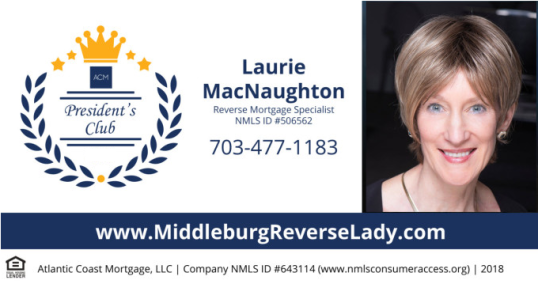Laurie MacNaughton © 2020
When she called Saturday I was pretty sure I knew what the conversation would involve.
“We’re both in our 80’s, my husband is four years into an Alzheimer’s diagnosis, and our kids live in Nevada. The biggest thing is our investments are getting low.” And then there was this: “But we don’t want our kids to know.”
We don’t want our kids to know. It’s one of the worst statements I hear in the course of my job.
A couple things about this. First, I’m a parent. I understand about not wanting to worry kids, adults though they may be. But I’m also a lender who frequently talks to adult kids worried about their parents.
Would you like to hear how that side of the conversation goes? It’s something like this: “My wife and I live in Nevada but my aging parents are in Virginia. We’re worried about their finances – but they won’t talk about money.”
The risk to adult kids is this: if you do not help parents with the solution, it may get to the point where you are the solution. And odds are good you’re not really the best solution. I have seen adult children quit their job to become a caregiver. I have seen tension in marriages, finances under strain, 401(k)s prematurely tapped. The risk to aging parents is that if your finances are deeply stressed by the time you involve your kids, it’s almost guaranteed they’re going to have to help.
Nobody is going to say the money conversation is anything other than awkward for many people. Talking about money is not fun. But talking about overdue bills is even less fun.
These are anxious times for many, and times may well continue to be anxious for many months to come. There is little we can do to eliminate stress caused by world events. However, there are steps you can take that may greatly reduce hardship, whether you’re an aging parent or the adult child of aging parents.
Three recommendations I often make are the following: first, awkward as it may be, talk to family. These conversations do not get easier over time, so just do it.
Second, pre-crisis, the homeowner should speak with a qualified financial planner, accountant, or elder law attorney who can help put together long-range plans.
Third, the homeowner should consider using the home as a source of retirement funding. Several options exist here, including selling the home and downsizing, renting out a portion of the home, or doing a reverse mortgage.
If you have questions about how you or one you love may benefit from a reverse mortgage, or if you would like contact information for an elder law attorney, accountant, or wealth manager, give me a call. I always love hearing from you.










